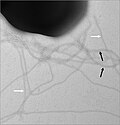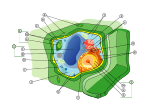A hyperthermophile is an organism that thrives in extremely hot environments—from 60 °C (140 °F) upwards. An optimal temperature for the existence of hyperthermophiles...
17 KB (2,078 words) - 13:00, 19 November 2024
single described species, Methanopyrus kandleri. It is a rod-shaped hyperthermophile, discovered on the wall of a black smoker from the Gulf of California...
12 KB (1,291 words) - 18:12, 30 October 2024
50–64 °C (122–147 °F) Extreme thermophiles 65–79 °C (149–174 °F) Hyperthermophiles 80 °C (176 °F) and beyond, but not below 50 °C (122 °F) In a related...
12 KB (1,260 words) - 23:01, 22 October 2024
Halophiles, organisms that thrive in highly salty environments, and hyperthermophiles, organisms that thrive in extremely hot environments, are examples...
12 KB (1,293 words) - 03:34, 27 October 2024
anaerobic, extremophilic, model species of archaea. It is classified as a hyperthermophile because it thrives best under extremely high temperatures, and is notable...
29 KB (3,463 words) - 04:35, 21 August 2024
submarine thermal springs and oil wells. It is an anaerobic organotroph hyperthermophile that is between 0.5–3.0 μm (20–118 μin) in diameter. Like the other...
9 KB (1,027 words) - 13:35, 30 October 2024
320 km (200 mi) off Puget Sound near a hydrothermal vent, it is a hyperthermophile, able to reproduce at 121 °C (250 °F), hence its name. It was (at the...
3 KB (333 words) - 20:48, 4 November 2024
Pyrodictium abyssi is a species of heterotrophic marine archaeal hyperthermophile that can grow at 110 °C (230 °F). Its type strain is AV2 (DSM 6158)....
3 KB (256 words) - 05:55, 25 March 2022
recent common ancestor (MRCA) of bacteria and archaea was probably a hyperthermophile that lived about 2.5 billion–3.2 billion years ago. The earliest life...
143 KB (15,534 words) - 20:00, 8 November 2024
Prieur, Daniel (July 2009). "Pyrococcus CH1, an obligate piezophilic hyperthermophile: extending the upper pressure-temperature limits for life". The ISME...
15 KB (1,726 words) - 09:13, 2 June 2024
PMC 6095482. PMID 30114187. Stetter, Karl O (29 October 2006). "Hyperthermophiles in the history of life". Philosophical Transactions of the Royal Society...
19 KB (1,933 words) - 09:34, 22 November 2024
environments that are normally fatal to most life-forms. Thermophiles and hyperthermophiles thrive in high temperatures. Psychrophiles thrive in extremely low...
74 KB (7,752 words) - 01:23, 14 November 2024
high temperatures that kill most organisms. P. fumarii is known as a hyperthermophile obligately chemolithoautotroph. In the simplest terms, this archaea...
10 KB (1,024 words) - 16:03, 17 November 2024
Thermophiles prefer temperatures from 50 to 70 °C (122 to 158 °F), while hyperthermophiles grow better at temperatures as high as 80 to 110 °C (176 to 230 °F)...
51 KB (5,138 words) - 12:45, 2 November 2024
reverse gyrase topoisomerase is found exclusively in thermophiles and hyperthermophiles as it allows for coiling of DNA. The reverse gyrase enzyme requires...
204 KB (21,073 words) - 09:31, 23 October 2024
PMID 24898023. Di Maio F, Egelman EH, et al. (2015). "A virus that infects a hyperthermophile encapsidates A-form DNA". Science. 348 (6237): 914–917. Bibcode:2015Sci...
12 KB (1,229 words) - 11:46, 27 September 2024
Di Giulio, M. (2003) The universal ancestor was a thermophile or a hyperthermophile: Tests and further evidence. J Theor Biol 221: 425-436. Griffiths,...
16 KB (1,708 words) - 01:52, 3 July 2024
was discovered in anaerobic archaea. It was proposed in 2008 for the hyperthermophile archeon Ignicoccus hospitalis. CO2 fixation is catalyzed by enoyl-CoA...
43 KB (3,852 words) - 14:24, 18 July 2024
1007/bf01768019. PMID 660662. S2CID 1291732. Stetter KO (1996). "Hyperthermophiles in the history of life". Ciba Foundation Symposium. 202: 1–10, discussion...
158 KB (16,722 words) - 19:34, 6 November 2024
depending on their growth habit. In contrast, catalase isolated from the hyperthermophile archaeon Pyrobaculum calidifontis has a temperature optimum of 90 °C...
39 KB (4,277 words) - 04:57, 2 November 2024
compared to its relative Archaeoglobus. F. placidus was the first hyperthermophile discovered to grow anaerobically by oxidizing aromatic compounds such...
6 KB (640 words) - 22:22, 15 April 2023
article discusses the Unique properties of hyperthermophilic archaea. Hyperthermophiles are organisms that can live at temperatures ranging between 70 and...
17 KB (2,551 words) - 21:54, 11 April 2024
dependence on sulfur and are important as carbon fixers. There are hyperthermophiles in hydrothermal vents and other groups are the most abundant at depths...
11 KB (829 words) - 06:05, 5 August 2024
wall among the Archaea consists of glycoprotein, and occurs in the hyperthermophiles, Halobacterium, and some methanogens. In Halobacterium, the proteins...
43 KB (4,765 words) - 05:01, 2 November 2024
island has volcanic activity, it is a place where thermophiles and hyperthermophiles are found. The hyperthermophilic archaean Pyrococcus furiosus was...
15 KB (1,672 words) - 04:50, 12 November 2024
structure of phosphoserine phosphatase from Methanococcus jannaschii, a hyperthermophile, at 1.8 A resolution". Structure. 9 (1): 65–71. doi:10.1016/s0969-2126(00)00558-x...
61 KB (6,770 words) - 15:11, 20 August 2024
Pseudothermotoga. The genus Thermotoga represents the majority of existing hyperthermophiles and are unique in that they are wrapped in an outer membrane that...
18 KB (1,664 words) - 17:55, 22 March 2024
pressure at such depth, but from the increased temperature. Judging from hyperthermophile organisms, the temperature limit is at about 120 °C (Strain 121 can...
31 KB (3,459 words) - 11:00, 7 November 2024
and has also been isolated from the hot springs in Yellowstone. As a hyperthermophile, "A. aeolicus" can survive up to 95 °C with a temperature optima of...
10 KB (1,099 words) - 13:49, 19 November 2024
Di Giulio M. (2003). "The universal ancestor was a thermophile or a hyperthermophile: Tests and further evidence". J Theor Biol. 221 (3): 425–436. Bibcode:2003JThBi...
22 KB (1,979 words) - 01:53, 3 July 2024

















